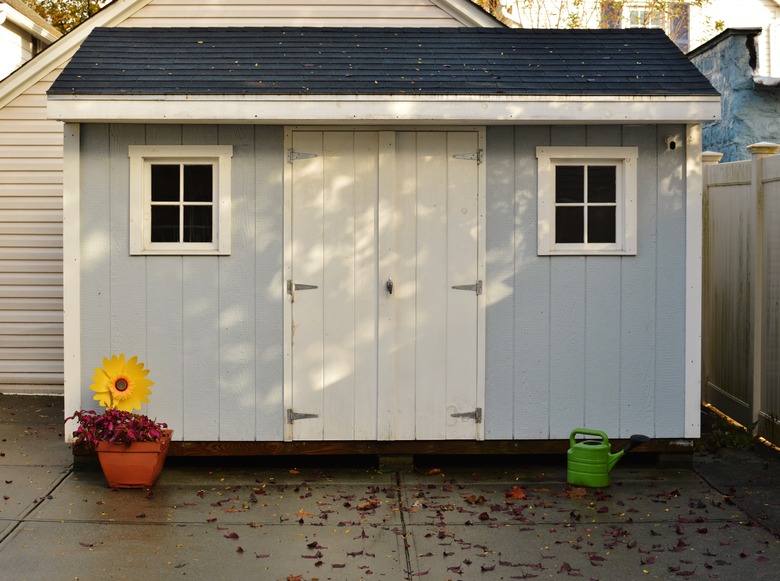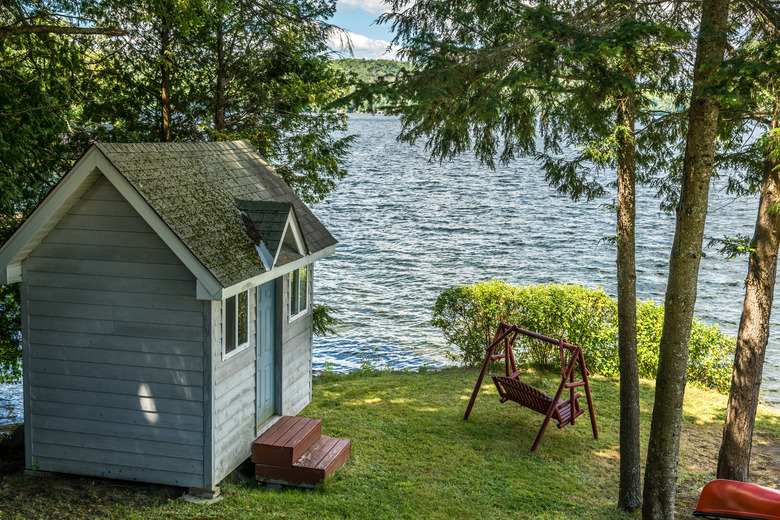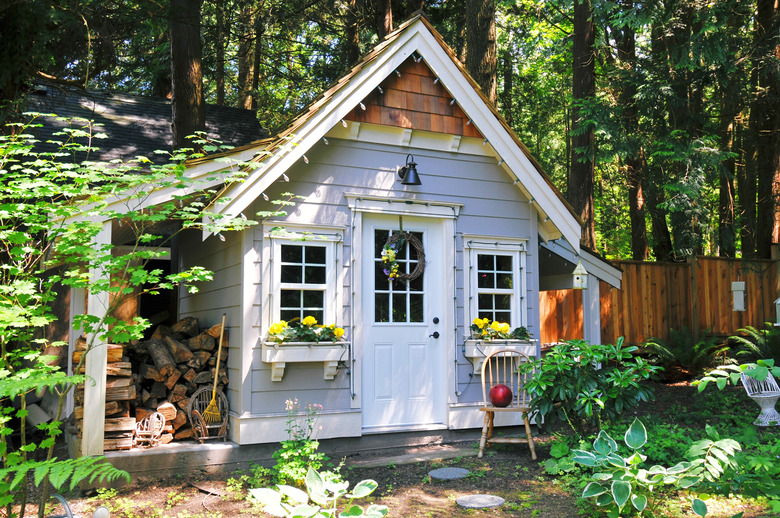DIY Garden Sheds: A Beginner's Guide
We may receive a commission on purchases made from links.
If you're considering a new garden shed, one of your first decisions will be whether or not to build it as a DIY project or purchase a prefabricated unit. There's a wide selection of prefab units out there, and all it takes is a couple of mouse clicks to have one delivered to your door. Even though it's much less work than a DIY shed, a prefab unit doesn't get you off the hook entirely because you still have to build a foundation and assemble the shed on top of it. Nevertheless, if all you want is a functional storage shed for your gardening tools, a prefab unit is a time-saving option that frees you from the tasks of drawing designs and purchasing materials.
On the other hand, you may be energized by the thought of designing and building your own garden shed. You'll be able to tweak the design to fit your landscape and suit your needs, which may include using it as a workshop or retreat space as well as a storage shed. In that case, you have more decisions to make about the size, foundation, roof and siding styles, materials and color. If you're the DIY type, you thrive on this type of creativity.
Characteristics of a Good Garden Shed
Characteristics of a Good Garden Shed
To get an idea of what constitutes a good garden shed, it helps to first identify that it is not a dwelling unit. It doesn't have plumbing, the walls typically aren't insulated (although they can be) and it may or may not have electricity. Owing to the fact that it isn't a dwelling unit, a small tool shed under a minimum size doesn't even count as a building and doesn't require a permit in many jurisdictions, but this isn't universal. It's important to check with your building department and homeowners' association to determine which factors, such as size, usage and electricity requirements, trigger the permitting process.
A good garden shed can be a storage space for garden tools, a potting bench, power tools, a place to do woodworking and even a playhouse, and to fulfill these and other functions, it must be watertight and stable. It must be on a solid foundation that keeps it level and above ground, and it must have weatherproof siding and a sturdy roof. It doesn't need to be heavy, though; a lightweight shed made of metal or plastic can be as useful as one made of wood. One more thing — a good garden shed, whether it's prefab or custom built, either adds visual appeal to your landscape or is unnoticeable and doesn't detract from the visual appeal.
Sizing Your Shed
Sizing Your Shed
One of the most common mistakes homeowners make is to err on the side of economy and undersize their new shed. It's natural to try to save money, and no one wants a shed that takes over the landscape, but it usually doesn't cost much more to upgrade the size to make the shed really useful, and there are better ways to optimize the shed's visual impact than making a small shed. For example, you can choose an attractive style and attractive materials that complement the landscape, or you can hide the shed with bushes or vines.
If you're planning the shed primarily for storage, use an online size estimator, such as the one at LP Outdoor Building Solutions, to help you determine how much space you need based on what you want to store. On the other hand, you may intend to use the shed as a hangout, an office or a she-shed complete with designer decor, in which case you need to provide space for furniture. Draw an outline on the ground, bring out some furniture and move it around to gauge whether the space you've given yourself is adequate. Remember that too much space inside your backyard shed is better than not enough space.
The Prefab Storage Shed Option
The Prefab Storage Shed Option
While it may be a demanding job to build a garden shed, it isn't as difficult as building a dwelling unit, but it's far less work to assemble a prefab unit, and that's often the best solution when you're looking for basic storage space. Prefab units made from metal, plastic, wood and even fabric are all available in sizes from mini to jumbo, and each has its benefits:
- Metal sheds are lightweight if somewhat difficult to assemble and are less expensive than plastic or wood units. They come with or without floors, giving you the option to add your own solid plywood floor. They're probably not the best choice for high-wind environments, although they can be anchored to the ground to resist wind. Metal sheds provide the least amount of protection from the sun's heat, and temperatures inside can get high.
- Plastic sheds made of rigid vinyl or resin have been gaining popularity because they are easy to assemble, completely watertight and available in a variety of designs. A large, plastic garden shed can easily serve multiple purposes, and because plastic doesn't rot or rust, it can outlast most other shed materials.
- Prefab wood sheds are typically constructed with less robust materials than you would use if you built your own shed, but a wood shed doesn't look out of place in any garden or backyard. You can often purchase preassembled wooden sheds that require little if any assembly, and owing to the insulating properties of wood, the environment inside is more pleasant.
Besides assembling the prefab shed, you also have to provide a foundation for it, but that's also true if you build your own shed as a DIY project, so it's good to take a look at foundation possibilities.
Shed Foundation Possibilities
Shed Foundation Possibilities
All in all, there are roughly a dozen different ways to build a shed foundation, ranging from simple skid or gravel foundations to more complex post-and-pier constructions to pouring a concrete pad. The purpose of the foundation is two-fold: to keep the base of the shed off the ground and away from moisture and to keep it level. When erecting a prefab shed building, you generally don't need a complex foundation structure when an easier and less expensive one will do. In order of cost and complexity, some of the more common foundation options include:
- On-grade skids made from 6x6 or 8x8 pressure-treated timbers are placed on shallow trenches filled with compacted gravel. The shed floor rests on the skids.
- You fill an on-grade frame constructed with pressure-treated timbers with compacted gravel, or you partially fill it with gravel and sand to form a base for pavers or cement blocks.
- Place plastic or metal permeable pavers on the ground and fill them with gravel. This foundation doesn't require a frame, but the ground may have to be excavated to make it level.
- Dig posts into the ground to a depth below the frost line and set them in concrete. Then, attach beams to the posts.
- Place concrete pier blocks on-grade, level them with one another and set beams across them. A variation for sloping ground is to attach posts to the pier blocks and attach the beams to the posts. The posts can be cut to whatever length necessary to make the beams level.
- Set cardboard tubes into the ground below the frost line and fill them with concrete, just like deck footings. Embed brackets in the tops of the concrete-filled tubes while the concrete is fresh and attach posts or beams to the brackets.
Shed Design and Roof Style
Shed Design and Roof Style
If you're just learning how to build a shed, you probably won't want to stray from the traditional rectangular footprint that most utility outbuildings have, and if you purchase a prefab unit, that's probably the shape it will have. Buildings with offbeat footprints, such as hexagonal or octagonal, are harder to build, and there are few reasons to introduce complexity into your DIY project if the end result will simply be more storage space in the yard.
You will have a design decision to make when it comes to the roof, however, and while there are a dozen or so possibilities, only a few are practical for a DIY shed:
- The traditional shed-style roof is a flat roof that slopes down from the front of the building to the back. It needs a pitch between 2/12 (2 inches per foot) and 4/12 for effective runoff, and it can be covered with asphalt, metal or plastic roofing. It's the easiest roof to build, and it's the easiest one on which to mount solar panels. A shed roof with a slope less than 2/12 is a flat roof, and it needs to be covered with a material that can handle standing water, such as thermoplastic polyolefin, spray polyurethane foam or tar and gravel.
- A peaked roof is slightly more difficult to build, but it gives the shed gables on both sides, and that makes the shed look like a house. The roof peak provides extra space inside the building for a loft or attic, and this type of roof style makes the building easier to vent, which is important in cold, wet places where condensation is a problem. A saltbox roof is a variation with one side of the roof being wider than the other.
- A gambrel roof is also known as a barn roof, and if you want to maximize space inside your storage shed or she-shed, it's the best option. This type of roof has a peak, but the top of the roof has a gentle slope that transitions to a much steeper slope near the walls. It's more difficult to build, but if you want a comfortable loft space in your she-shed and you want to add a touch of Dutch colonialism to your landscape, this should be on your list of possibilities.
Choosing Siding Materials
Choosing Siding Materials
When drawing your garden shed plans and choosing which type of siding to add to your materials list, you want to consider durability, appearance, cost and maintenance requirements. Vinyl siding, followed closely by fiber cement and metal, scores highly on all counts, and it requires little to no maintenance. Keep in mind that strips, planks or shingles of any material call for an underlayment of plywood sheathing, which is an extra expense. You won't need sheathing if you install fiber cement panels or T1-11, which is exterior-grade plywood milled with a rough-sawn finish.
Vinyl and metal siding come pre-painted, and not all types can be repainted unless you use special paint, but fiber cement and plywood come with no finish or just a primer coat, so you need to paint or stain them. Use a good-quality product, preferably containing a mildewcide to control mold in order to avoid having to repaint in a few years. With occasional cleaning and repainting or staining, the shed should maintain its appearance for at least 15 to 20 years.


